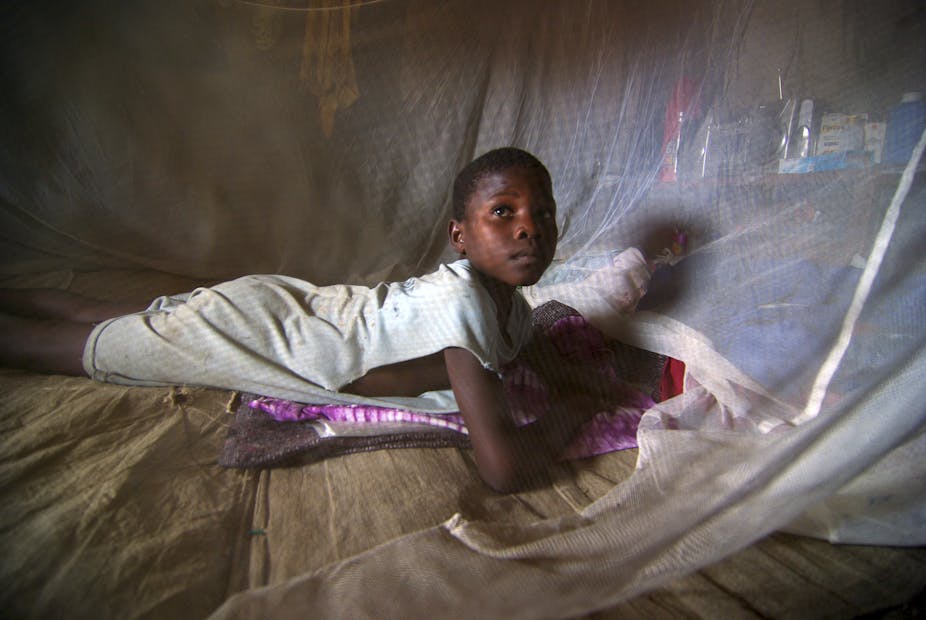Kenya’s two major malaria prevention strategies – indoor residual spraying of homes in high transmission areas and the issuing of insecticide treated nets – have led to a significant reduction in malaria transmission.
The two methods were introduced in the country’s western highlands, traditionally considered a high transmission area, about a decade ago and have resulted in the disease’s caseload decreasing by about 80%.
But the drop in cases has brought a new challenge: people have begun losing their immunity to the disease. The consequence is that they are prone to contracting more complicated forms of the malaria that could result in death.
There are two types of immunity that people are able to develop naturally: clinical immunity and parasitological immunity.
People living in high transmission areas develop clinical immunity naturally after being exposed to the parasite and receiving successful treatment. Their bodies are able to resist infection.
They are also able to develop parasitological immunity. After being bitten by many infected mosquitoes over a long period, their bodies are able to withstand higher numbers of parasites in their blood.
When people don’t have parasitological immunity, they face the risk of becoming severely ill when the number of parasites in the blood increases. This can take the form of severe anaemia, cerebral malaria and eventually death. Children are particularly susceptible.
In our study we focused on parasitological immunity in children. We wanted to understand how malaria prevention interventions such as bed nets and indoor spraying were preventing people from developing parasitological immunity.
We found that children who were less exposed to malaria as they grew up had lower levels of parasitological immunity. This exposed them to developing more severe strains of malaria.
Our findings should be taken on board as part of Kenya’s broader malaria prevention strategies. The government needs to maintain strong monitoring and surveillance networks to ensure that existing interventions are still sufficient. And it needs to work out new interventions to deal with the consequences of its interventions.
Our study
There is no functional test to measure the level of immune protection a person has developed. Some people have higher levels of immunity with fewer parasites in their blood.
Even though it’s not possible to pin down how individuals will react to malaria it is nevertheless possible to work out a person’s parasitological immunity.
Parasitological immunity is established by measuring the proportion of red blood cells that are infected in the body. Most people who get malaria have less than 1% of their red blood cells infected with the parasite, which rapidly multiplies. A person with 5% of their red blood cells infected is considered severely toxic.
We compared two sets of children, looking at the relationship between age and parasite density. We did two sets of surveys nine years apart. The first was done between June 2002 and December 2003 and the second between January 2012 and February 2015. School children between the ages of six and 13 were tested for malarial parasites in both periods.
When we did the first set of tests, malaria prevention tools had not yet been introduced in the highlands. The second set of children were exposed to the prevention tools.
We recorded the blood parasite densities – and thus infections trends – in each of the age groups. By doing this we were able to compare how the parasite density had changed between those who had grown up with bednets and indoor spraying or taken anti-malarial drugs, and those who hadn’t.
We found that people who had not experienced early interventions had high levels of immunity.
A new gap
But there’s a knock-on effect that complicates the scenario even further. People who hadn’t taken anti-malarial medicines or used treated bed nets were more likely to infect mosquitoes because they continued to carry parasites in their blood.
This makes the rest of the population more susceptible to infections, with implications for the country’s broader malaria prevention strategy.
The risk of increased infection brings added complexity to government’s efforts. The only way to meet the challenge is to ensure that there are sufficient monitoring and surveillance strategies.
Another reason monitoring and evaluation matters is because mosquitoes are able to evolve and develop resistance to insecticides. In addition malaria parasites can become resistant to anti-malarial drugs.
Mosquitoes have also been shown to change their behaviour, such as avoiding contact with insecticide treated surfaces. Where bed nets are used they have been shown to change from night time feeding to daytime or evenings before people go to sleep.
If the government does not pick up these new trends early, as well as new and more severe infections, it will lose the gains it’s made against fighting malaria.

